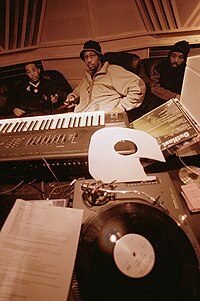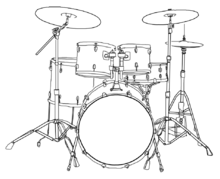
A disc jockey, more commonly abbreviated as DJ, is a person who plays recorded music for an audience. Types of DJs include radio DJs, club DJs, mobile DJs, and turntablists. Originally, the "disc" in "disc jockey" referred to shellac and later vinyl records, but nowadays DJ is used as an all-encompassing term to also describe persons who mix music from other recording media such as cassettes, CDs or digital audio files on a CDJ, controller, or even a laptop. DJs may adopt the title "DJ" in front of their real names, adopted pseudonyms, or stage names.

Marlon Lu'Ree Williams, better known by his stage name Marley Marl, is an American DJ, record producer, rapper and record label founder, primarily operating in hip hop music. Marlon grew up in Queensbridge housing projects located in Queens, New York. He performed in local talent shows during the early days of rap music, further fueling his interest.
Breakbeat is a broad type of electronic music that uses drum breaks, often sampled from early recordings of funk, jazz, and R&B. Breakbeats have been used in styles such as Florida breaks, hip hop, jungle, drum and bass, big beat, breakbeat hardcore, and UK garage styles.
Dub is a musical style that grew out of reggae in the late 1960s and early 1970s. It is commonly considered a subgenre of reggae, though it has developed to extend beyond that style. Generally, dub consists of remixes of existing recordings created by significantly manipulating the original, usually through the removal of vocal parts, emphasis of the rhythm section, the application of studio effects such as echo and reverb, and the occasional dubbing of vocal or instrumental snippets from the original version or other works.

Scratching, sometimes referred to as scrubbing, is a DJ and turntablist technique of moving a vinyl record back and forth on a turntable to produce percussive or rhythmic sounds. A crossfader on a DJ mixer may be used to fade between two records simultaneously.
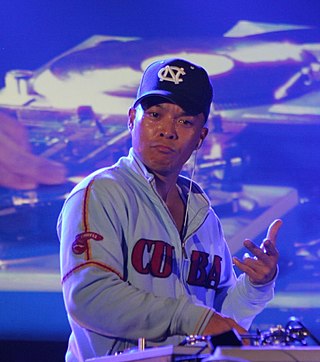
Turntablism is the art of manipulating sounds and creating new music, sound effects, mixes and other creative sounds and beats, typically by using two or more turntables and a cross fader-equipped DJ mixer. The mixer is plugged into a PA system and/or broadcasting equipment so that a wider audience can hear the turntablist's music. Turntablists typically manipulate records on a turntable by moving the record with their hand to cue the stylus to exact points on a record, and by touching or moving the platter or record to stop, slow down, speed up or, spin the record backwards, or moving the turntable platter back and forth, all while using a DJ mixer's crossfader control and the mixer's gain and equalization controls to adjust the sound and level of each turntable. Turntablists typically use two or more turntables and headphones to cue up desired start points on different records.
Electro is a genre of electronic dance music directly influenced by the use of the Roland TR-808 drum machines, with an immediate origin in early hip hop and funk genres. Records in the genre typically feature heavy electronic sounds, usually without vocals; if vocals are present, they are delivered in a deadpan manner, often through electronic distortion such as vocoding and talkboxing. It palpably deviates from its predecessor boogie by being less vocal-oriented and more focused on electronic beats produced by drum machines.
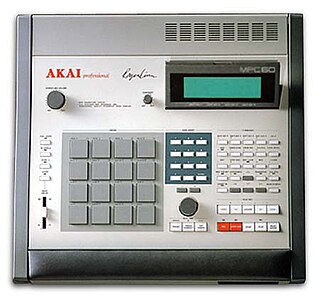
The Akai MPC is a series of music workstations produced by Akai from 1988 onwards. MPCs combine sampling and sequencing functions, allowing users to record portions of sound, modify them and play them back as sequences.
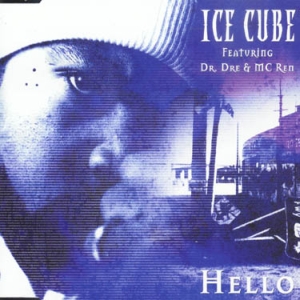
"Hello" is a song written and performed by American rappers and former N.W.A members Ice Cube, Dr. Dre and MC Ren. It was released in 2000 via Priority Records as the third and final single from Ice Cube's sixth solo studio album War & Peace Vol. 2 . Produced by Dr. Dre, with Mel-Man serving as co-producer, it features backing vocals from Traci Nelson.
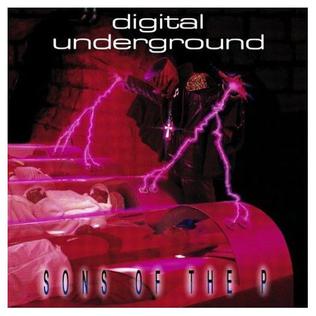
Sons of the P is the second studio album by American hip hop group Digital Underground. It was released on October 15, 1991, via Tommy Boy Records. Main recording sessions took place at Starlight Sound in Richmond, with additional recordings done at Unique Recording Studios in New York, Axiom Recorders in Tampa and The Disc Ltd. in Detroit. Production was handled by D.U. in-house production team credited as The Underground Production Squad, with Atron Gregory and member Shock G serving as executive producers. It features contributions from George Clinton, Stretch and Treach.

In sound and music, sampling is the reuse of a portion of a sound recording in another recording. Samples may comprise elements such as rhythm, melody, speech, or sound effects. A sample can be brief and only incorporate a single musical note, or it can consist of longer portions of music, and may be layered, equalized, sped up or slowed down, repitched, looped, or otherwise manipulated. They are usually integrated using electronic music instruments (samplers) or software such as digital audio workstations.
Hip-hop or hip hop, formerly known as disco rap, is a genre of popular music,that emerged in the late 1960s and early 1970s primarily from African American, Afro-Latin, and Afro-Caribbean musical aesthetics practiced by youth in the South Bronx. Hip-hop music originated as an anti-drug and anti-violence social movement led by the Afrika Bambaataa and the Universal Zulu Nation. The genre is characterized by stylized rhythmic sounds—often built around disco grooves, electronic drum beats, and rapping, a percussive vocal delivery of rhymed poetic speech as consciousness-raising expression. The music developed as part of the broader hip-hop culture, a subculture defined by four key stylistic elements: MCing/rapping, DJing/scratching with turntables, breakdancing, and graffiti art or writing. Knowledge is sometimes described as a fifth element, underscoring its role in shaping the values and promoting empowerment and consciousness-raising through music. In 1999, emcee KRS-One, often referred to as "The Teacher," elaborated on this framework in a Harvard lecture, identifying additional elements that extend beyond the basic four. These include self-expression, street fashion, street language, street knowledge, and street entrepreneurialism, which remain integral to hip-hop's musical expression, entertainment business, and sound production. Girls’ double-dutch was also recognized as a key stylistic component of breakdancing, according to KRS. While often used to refer solely to rapping and rap music, "hip-hop" more properly denotes the practice(s) of the entire subculture. The term hip-hop music is sometimes used synonymously with the term rap music, though rapping may not be the focus of hip-hop music. The genre also centers DJing, turntablism, scratching, beatboxing, and instrumental tracks.

Lexus Arnel Lewis, professionally known as Lex Luger, is an American record producer. His stage name is a homage to the former WCW/WWF professional wrestler Lex Luger. He co-founded the American hip hop production team 808 Mafia with Southside. He is a member of the hip hop production duo Low Pros with A-Trak, and the VABP, a hip hop group that he founded in high school.
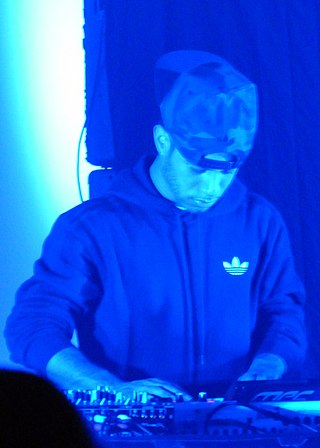
Abraham Orellana, better known as his stage name AraabMuzik, is an American record producer and DJ. He made a name for himself by performing beats and instrumentals live and in real time on a AkaiPro Music Production Center (MPC) drum machine. He uses MPC to produce rapid, rhythmic drum patterns and creates melodies with samples and other sounds.
Boom bap is a subgenre and music production style that was prominent in East Coast hip hop during the golden age of hip hop from the late 1980s to the early 1990s.

Joshua Howard Luellen, known professionally as Southside, is an American record producer, rapper and songwriter. Based in Atlanta, he is recognized in the music industry for his aggressive, trap-infused production work for prominent hip hop artists. His association with hometown rapper Waka Flocka Flame led Luellen to sign to his label Brick Squad Monopoly, an imprint of Gucci Mane's 1017 Records, as in-house talent in 2010. Luellen and labelmate, fellow producer Lex Luger established the production team 808 Mafia that same year, who were credited on several commercially successful releases throughout the remaining decade.

Joshua Paul Davis, better known by his stage name DJ Shadow, is an American DJ and record producer. His debut studio album, Endtroducing....., was released in 1996. He is known for layered production that uses numerous samples, often from obscure sources, to create new compositions and whose music was described in Allmusic as having "revolutionized hip-hop".
Memphis rap, also known as Memphis hip hop, or Memphis horrorcore, is a regional subgenre of hip hop music that originated in Memphis, Tennessee in the mid-late 1980s.
The Triggerman beat, also known as Triggaman, is a one-bar drum loop that originated from sampling "Drag Rap" by the Showboys and "Brown Beats" by Cameron Paul. The one-bar drum loop and bells was known to be used in bounce music, having been used in hundreds of records. The beat has been influential in recent hip hop music, including Juvenile's "Back That Azz Up", David Banner's "Like a Pimp", T.I. and Lil Wayne's "Ball", Drake's "Nice for What" and "In My Feelings", and also "Go Crazy" by Chris Brown and Young Thug.
Plugg is a sub-genre of trap music that emerged in the mid-2010s via online distribution on platform SoundCloud. It was popularized by melodic Southern hip hop artists, and is characterized by deep 808 basslines, sparkly melodies, and melodic vocals.
